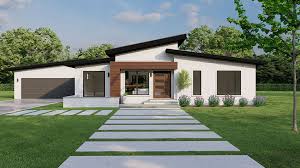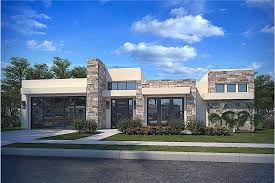The modern home is evolving. Gone are the days of sprawling, energy-guzzling mansions. Today’s homeowner craves efficiency, functionality, and a connection to the environment. This is where the concept of “smart spaces” comes in. These are modern house plans designed with intention, maximizing livability while minimizing waste.
Contents
Modern House Plans:
Modern house plans are the canvas for creating your smart space. These designs prioritize clean lines, open floor plans, and expansive windows. This focus on openness fosters a connection between the indoors and outdoors, allowing natural light to bathe the interior and blur the lines between living areas. Modern house plans are not just aesthetically pleasing; they’re a perfect fit for the smart space philosophy, promoting energy efficiency and a seamless flow of movement throughout the home.
The Rise of Smart Spaces
Several factors contribute to the rise of smart spaces. One is the growing awareness of environmental impact. Smaller homes require fewer resources to build and maintain, leading to a reduced carbon footprint. Additionally, the high cost of real estate, particularly in urban areas, necessitates maximizing space utilization. Finally, a shift in lifestyle preferences is pushing for more dynamic and adaptable living environments.
Read more about Residential Painting for Interior Spaces

Key Features of Smart Spaces
So, what defines a smart space? Here are some key characteristics you’ll find in modern house plans designed for efficiency:
Open Floor Plans
Open floor plans eliminate unnecessary walls, creating a sense of spaciousness in a smaller footprint. This allows for better natural light flow and fosters a more connected living environment. Living areas like the kitchen, dining, and living room often merge into a single space, promoting interaction and fostering a sense of community within the home.
Multifunctional Rooms
Smart spaces prioritize flexibility. A room can transition from a home office by day to a guest room by night with the help of clever furniture choices and space-saving designs. Murphy beds, folding desks, and built-in storage solutions are all essential tools for maximizing functionality in a single space.
Smart Storage
Every nook and cranny gets put to good use in a smart space. Built-in storage solutions like floor-to-ceiling cabinets, hidden compartments, and under-stair drawers eliminate clutter and maximize organization. Vertical storage utilizes wall space efficiently, keeping things off the floor and creating a sense of openness.
Energy Efficiency
Smart spaces prioritize sustainability. Techniques like strategically placed windows for natural light and ventilation, energy-efficient appliances, and high-performance building materials contribute to lower energy consumption and reduced utility bills.
Smart Technology
Automation plays a vital role in smart spaces. Smart thermostats, lighting controls, and security systems optimize comfort and convenience while maximizing efficiency. Integration with voice assistants and home automation systems allows for seamless control and monitoring of your home environment.
Benefits of Smart Spaces
Living in a smart space offers a multitude of benefits:
Reduced Cost
Smaller living spaces translate to lower construction costs. Additionally, energy-efficient features lead to lower utility bills, saving you money in the long run.
Increased Efficiency
Smart layouts and organizational solutions streamline daily routines. Less space means less cleaning and maintenance, freeing up your time for the things you enjoy.
Improved Sustainability
Environmentally conscious features make a positive impact by reducing energy consumption and resource use.
Enhanced Comfort
Open floor plans, natural light, and smart technology create a comfortable and inviting living environment.
Stronger Connection
Flexible and shared spaces foster closer relationships and a stronger sense of community within the home.
Examples of Smart Space Designs
Modern architects are constantly innovating with smart space designs. Here are a few examples:
Tiny Homes
These compact dwellings, often under 400 square feet, prioritize efficient use of space and often come equipped with innovative features like composting toilets and rooftop gardens.
Convertible Studios
Urban living often necessitates maximizing a single space. Convertible studios utilize furniture that transforms to create distinct living areas, maximizing functionality and adapting to different needs.
Multigenerational Homes
Smart design principles can be applied to create comfortable living environments for multiple generations under one roof. Separate living areas can be connected by shared spaces, fostering interaction while respecting individual needs.
Building Your Own Smart Space
Whether you’re building a new home or renovating an existing one, you can incorporate smart space principles. Here are some tips:
Hire an Architect
Collaborate with an architect who understands the principles of smart design and can translate your needs into a functional and efficient living space. Hiring an architect who specializes in sustainable and functional design can be your game-changer. They’ll translate your vision into a reality, optimizing space utilization, integrating smart technologies seamlessly, and ensuring your home aligns with green building principles. Their knowledge and experience will guide you through the design process, ensuring your smart space is not just trendy but efficient, comfortable, and built to last.
Prioritize Needs
Before diving headfirst into design ideas, take a step back and prioritize your needs. How many people will be living in the space? Do you require dedicated work areas or guest rooms? Consider how you’ll use each zone. Are you an entertainer who needs a spacious living area? Or perhaps a home chef who craves a well-equipped kitchen? By understanding your core necessities and lifestyle, you can design a smart space that perfectly complements your life, not the other way around.
Embrace Flexibility
Invest in furniture that can adapt to different uses. Opt for built-in storage solutions to maximize space. Smart spaces aren’t just about efficiency; they’re about adapting to your ever-changing life. Imagine a home office that transforms into a guest room for visiting family, or a living area that seamlessly transitions from a movie night hangout to a productive workspace. With clever furniture choices and multifunctional layouts, your smart space can bend and flow with your needs, ensuring maximum comfort and functionality in a streamlined environment.

Integrate Technology
Explore smart home technologies that can enhance comfort, security, and efficiency. Integrate technology seamlessly into your smart space to create a home that works for you. Smart thermostats and lighting systems can learn your routines and preferences, optimizing comfort and reducing energy use. Voice assistants can control everything from music to thermostats, simplifying daily tasks. Security systems with remote monitoring offer peace of mind, while smart appliances can streamline chores and even notify you when they need attention. By strategically integrating technology, you can transform your smart space into a haven of convenience, efficiency, and effortless living.
Consider Sustainability
Choose eco-friendly building materials and incorporate features that promote natural light and ventilation. Opt for eco-friendly building materials like recycled content or locally sourced wood. Invest in energy-efficient appliances and water-saving fixtures. Explore incorporating passive heating and cooling techniques through strategically placed windows, skylights, and proper insulation. A rainwater harvesting system or a rooftop garden can further reduce your environmental impact. Every sustainable choice you make contributes to a healthier planet and a more comfortable future for yourself and generations to come.
Conclusion
In conclusion, smart spaces are more than just a passing fad; they represent a paradigm shift towards a future of responsible and efficient living. By embracing these design principles, you’re not just creating a trendy home, you’re actively contributing to a more sustainable world. Ditch the McMansion mentality – with a smart space, less truly is more. You’ll enjoy a home that fosters a strong sense of community, maximizes comfort and convenience, and minimizes environmental impact.
Smart spaces are a testament to the power of thoughtful design, offering a blueprint for living well within our means and respecting the planet we call home. Whether you’re a young professional, a growing family, or an empty nester, there’s a smart space design solution waiting to be tailored to your unique needs. So, take a step towards a more mindful and fulfilling way of life – embrace the smart space revolution and create a home that’s as efficient as it is inviting.



